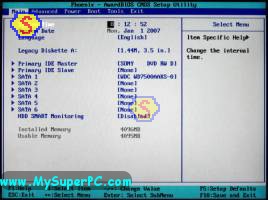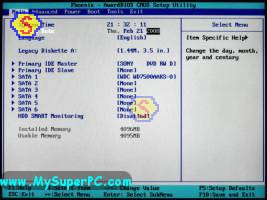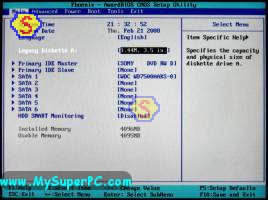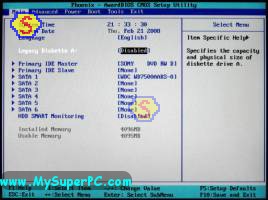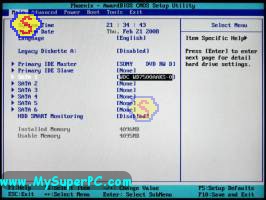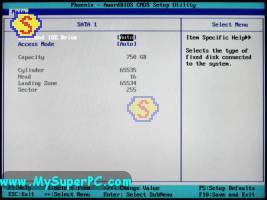Computer Assembly - How To Assemble A PC
Second Boot
We now have the minimum set of core components installed to have a real, live, working computer so it will be very exciting if everything checks out ok.
Connect the monitor, mouse, keyboard, and power cord to the back of the computer (if you haven't done so already from following the previous Connect The Speaker page). As with the first boot, turn the monitor on and give it 10 seconds to warm up. And still leave the computer case cover off.
What we'll do is enter the BIOS when the computer boots. The ASUS M2N32-SLI Deluxe Wireless Edition BIOS is entered by pressing the "Delete" key while the BIOS header screen is displayed. To make sure that my pressing of the key does not go undetected by the computer, I typically tap the "Delete" key at the rate of about twice a second while the BIOS header screen is displayed until the "CMOS Utility Menu" is displayed. Recall that the BIOS header screen is displayed immediately after the computer emits the single beep, so you can start tapping the "Delete" key as soon as you hear the beep. Note that different motherboards may use different keys to enter the BIOS.
Flip the power switch in back of the computer to the on position (set to 1 - one). This is it! Press the power button on the front of the computer case.
The computer should boot just as it did for the first boot. Enter the CMOS Utility Menu by pressing, or in my case tapping, the "Delete" key after the single beep is emitted. The "Main" menu tab is shown on entering the CMOS Utility Menu.
The "Main" menu tab is displayed. Notice the "Primary IDE Master" shows the value for the Sony DVD RW. Under "SATA 1" is the value for the Western Digital 750GB SATA hard drive. The cursor is on the hour field of the "System Time". The values for the date and time can now be set. Use the up/down arrow keys to navigate between the "System Time" and "System Date". Use the numeric keypad plus "+" and minus "-" keys to change the values within each field, and user the "Enter" key to set the value for a field and advance to the next field. The left/right arrow keys seem natural to use to change fields, but they actually navigate to the different tabs.
Now the date and time are correct. Notice that the setting for "Legacy Diskette A", which is the floppy drive, shows a value for the floppy drive. Use the down arrow to navigate to this field.
Using the plus "+" and minus "-" keys on the numeric keypad, change the value of the field to "Disabled".
Use the down arrow to cursor down to the "SATA 1" field. Press the "Enter" key.
The "SATA 1" menu shows the characteristics of the hard drive.
Pressing the "Escape" key once gets back to the "Main" menu.
Common Problems
As I mentioned under first boot common problems, if something goes wrong with any installation of hardware then first you should double-check your install and verify that you did what you meant to do. In this case that means checking that you set the jumpers the right way, plugged the ribbon cables in the right way around, and even actually remembered to connect the power cables and ribbon cables in the first place. Verify that the First Boot setup, meaning without any of the drive devices connected, still works.
If the computer is getting power, meaning that the fans are spinning, but it's not getting to the BIOS header screen then the most likely cause is the ribbon cable for the DVD RW drive, the optical drive. Either it is not connected the right way around or the ribbon cable is improper. Try a Second Boot again, but having only one drive connected, either the SATA hard drive which is connected via the SATA cable, or the DVD RW drive which is connected by the IDE ribbon cable. With each drive connected by itself, you should reach the BIOS header screen. If you do with one drive connected but not with the other drive connected then you know which drive is the one introducing the problem. The fault is most likely to be with the IDE ribbon cable, although it's possible that the drive itself or even the motherboard is faulty. In the case of the IDE ribbon cable, verify it is a proper IDE ribbon cable. IDE ribbon cables should be 18 inches in length, not 19 inches or 24 inches or any other inches. And they should be of high quality. If it's the IDE ribbon cable that came in the retail box of a quality motherboard then it should be ok. Or if it's a quality brand IDE ribbon cable such as Belkin then it should be ok. If you are not sure of the quality then you might want to try a different IDE ribbon cable.
If the First Boot setup works, but now with the Second Boot configuration the LED for a drive becomes lit and stays lit then this is for sure a bad or improperly installed ribbon cable. This happens particularly frequently with the floppy drive, if used, since the ends of the floppy drive ribbon cable are not color-coded and it's easy to plug the connector for the floppy drive into the motherboard and vice versa.
Back to My Super PC - Home Page
How To Build A Computer. Step By Step Instructions To Assemble. Skip To Any Assembly Step.
Back to My Super PC - Home Page
© 2001-2010, Rob Williams, all rights reserved.
|
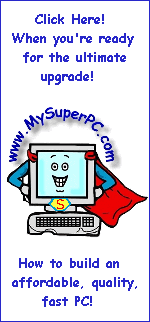
|
